Next issue CRJ out now
The cover story of this issue is that of Antimicrobial Resistance (AMR). On September 21, 2016, the United Nations is holding a high level meeting at the General Assembly on this subject – only the fourth time in UN history that a health topic will be discussed at this level. Marc Mendelson and Ramanan Laxminarayan explain why the issue is so important, while Saskia Popescu looks at the implications on global health and for first responders. Click here for summaries (full content only available to subscribers).
Comment: Brexit
Prince Michael of Liechtenstein introduces CRJ’s comment section on Brexit with an opinion piece on the way forward. CRJ presents a snapshot of thoughts from some of its Editorial Advisory Panel Members on the possible implications of Brexit on security, resilience and civil protection. Brian Dillon says that the UK has been a leading player in EU public safety exercise and, assuming a non-partisan, apolitical approach is taken, there is no reason this should change.
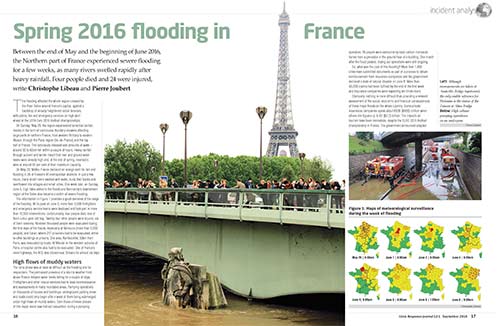
Flooding in France
Northern France experienced extreme flooding between the end of May and the beginning of June 2016, in which four people died and 24 were injured, write Christophe Libeau and Pierre Joubert.
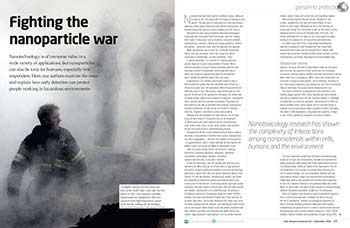
Medical care for all victims of war
Serena Leone introduces Emergency, an Italian-founded, international NGO that builds hospitals and healthcare facilities, and provides high quality, free healthcare in countries savaged by conflict.
Fighting the nanoparticle war
Nanotechnology is of immense value in a wide variety of applications, but nanoparticles can also be toxic for humans, especially first responders who are likely to encounter them at incidents. Our authors examine the issue and explain how early detection can protect people working in hazardous environments. Written by Dr Ian Portelli, Ashley Monaco, Carly Esteves and Emily Koehler.
Agriculture as a terrorist target
Agriculture and environmental systems are fundamental to human existence, but are often overlooked in the security context and are vulnerable to attack, writes Christoph Schroth, Lecturer in Paramedic Science at Bournemouth University UK.
ICDO and Swiss Co-operation
The ICDO and Switzerland have a long history of co-operation, summarised within this article.
Mass evacuation mission
Dr Jörg Szarzynski (Education Programme Director and Head of Section EduSphere at the United Nations University Institute for Environment and Human Security) and Albrecht Beck report from a combined IOM and UNDAC preparedness mission in the Republic of Vanuatu, which is considered to be the country most at risk of natural disasters in the world.
Victim identification
Jay Levinson and Avi Domb provide an insight into some of the complexities of identifying victims after an earthquake, warning that it can be a long and often time-consuming process.
Do not view urban resilience as a technocratic issue
The quest to make cities more resilient should not be considered to be a technocratic issue or a problem of how to manage people and spaces, says Laura Kavanagh, while Lisa Junghans describes methods for financing resilient cities.
Working together in Antarctica
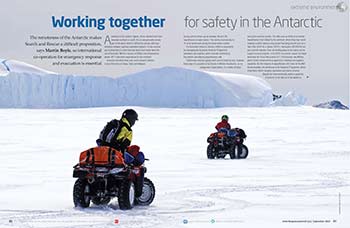
The remoteness of the Antarctic makes Search and Rescue a difficult proposition, says Martin Boyle, so international co-operation for emergency response and evacuation is essential.
Struggling with ‘dark dynamics’
Our crisis management techniques cannot handle today’s unmapped and poorly understood challenges, says Patrick Lagadec. It is time for a rethink on how leaders are challenged to cope with the unknown.
Crisis management: Moving from War Room to Board Room
Dr Tony Jaques says that many directors and CEOs would prefer not to think about crises. But the truth is that every executive and director should be concerned about crisis prevention and reputation.
Annual report on UK counter-terrorism strategy
Roger Gomm takes a look at the findings of the UK’s recent report into this subject which, in his opinion, indicate that terrorists continue to target crowded places that are less protected and that afford the most potential for mass fatalities and casualties.
Crime or terrorism: What’s in a name?
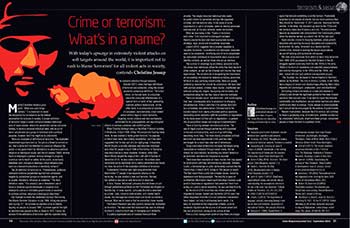
With today’s upsurge in extremely violent attacks on soft targets around the world, it is important not to rush to blame all and any violent attacks in society on terrorism, contends Christine Jessup.
Civil protection in an age of hyper-terrorism
Alex Townsend-Drake, an Emergency Planning Professional with expertise in complex political emergencies, reflects upon how to protect the security of citizens in an era of heightened terrorist threat, concluding that civil protection as an end can only be achieved through careful political change.
Unlocking sustainable conflict resolution
Casey Brunelle argues that strategic foresight is the pathway to sustainable conflict resolution, and that security and human development are not mutually exclusive in this day and age.
NATO stability policing
Lieutenant Colonel Vittorio Stingo of the Italian Caribinieri and a Stability Policing Expert at NATO Allied Command Transformation, describes how NATO is using Stability Policing to tackle future challenges generated by failing or collapsed nation states, in a holistic approach that involves both military and non-military actors.
Police mentoring: Negotiation and de-escalation
Andrew B Brown, who helped to train 2SCOTS, a light infantry unit tasked with Police mentoring in Afghan, describes de-escalation and negotiation techniques.
Working in hostile environments
Damascus, Kabul, Mogadishu and Benghazi – all conjure up notorious and threatening images in most people’s minds. Few would argue these are what we now commonly call ‘hostile’ or ‘fragile’ environments, writes Rob McAlister. So, what can you do to keep yourself safe?
Preparing the public for terrorism
Susan Anson and Hayley Watson of Trilateral Research, describe a recent project that looked into the complexities of preparing for terrorist attacks, amid findings that the preparedness actions are easier for other hazards, such as flooding or earthquakes.
Social media: A two-way street
Rob Shimmin explores how companies and emergency services might improve their use of social media, saying that the wider public might very well be inclined to help.
An ear to the ground or a head in the sand?
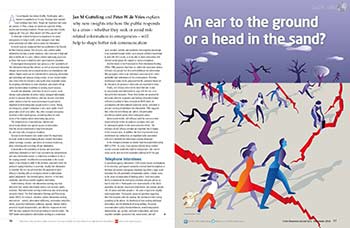
Psychologists Jan M Gutteling and Peter W de Vries explain why new insights into how the public responds to a crisis – whether they seek or avoid risk-related information in emergencies – will help shape better risk communication.
CRJ R&D: Robots that self-assemble
This issue, our regular section brings details of tiny, intricate robots that unfold themselves, bringing immense future potential to all manner of emergency situations. Written by Emily Koehler, Ian Portelli and Carly Esteves.
CRJ R&D: The potential of apps to save lives
Millions of people’s lives have already been changed thanks to the ingenuity of Apple’s HealthKit and ResearchKit. There is no telling how many lives will be saved in the future with the ever-evolving world of technology. Written by Ian Bogdanowicz, Carly Esteves, Emily Koehler, Ashley Monaco and Dr Ian Portelli.
Hashtag hazards
Steve Johnson and Terry Lewis (Programme Manager, Department of Homeland Security, USA) take a closer look at how authorities use social media, by focusing on Twitter in particular.
Instruction to innovation: Command and Control in the 21st Century
This new series by Dr David Rubens will identify some of the major issues involved in developing a multi-agency Incident Command System that is appropriate to today’s hyper-complex crisis and disaster management events.
Understanding and addressing the terrorist mindset
“There is an urgent need to abandon the mindset that fighting fire with fire is an effective, responsible and sustainable approach for policymakers at the highest levels when reacting to terrorist attacks, says Casey Brunelle. In the second part of this series, he adds that the need for perceptive direction in terms of understanding the terrorist mindset – and not outdated dogma – is more evident than ever before.
Helping the survivors of human trafficking
Emily Hough speaks to Shandra Woworuntu, who was trafficked and ensnared into sexual slavery in the US after answering an advertisement for a position in the hospitality industry. Today, Shandra works to raise awareness of the gaps in identifying and dealing with this crime, as well as the lack of assistance that is provided to its survivors.
Brian Dillon, 16/08/2016